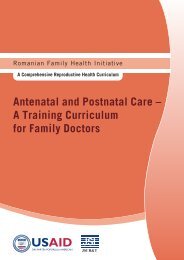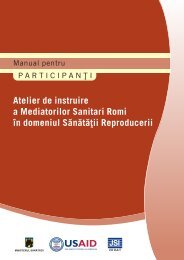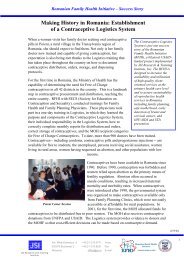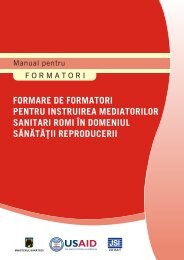Training of Roma Health Mediators in Reproductive Health
Training of Roma Health Mediators in Reproductive Health
Training of Roma Health Mediators in Reproductive Health
Create successful ePaper yourself
Turn your PDF publications into a flip-book with our unique Google optimized e-Paper software.
Tra<strong>in</strong>er document<br />
NORMAL BODY CHANGES DURING PREGNANCY<br />
• Weight <strong>in</strong>creases constantly dur<strong>in</strong>g pregnancy, approximately 1 kg/month until the<br />
7 th month <strong>of</strong> pregnancy, and then approximately 0.5 kg/week until delivery.<br />
• <strong>Reproductive</strong> organs<br />
o Uterus (womb) <strong>in</strong>creases <strong>in</strong> size dur<strong>in</strong>g pregnancy, start<strong>in</strong>g by the sixth week<br />
<strong>of</strong> pregnancy<br />
• 12 weeks: uterus can be felt at the level <strong>of</strong> the symphysis pubis<br />
• 20 weeks: uterus can be felt at the umbilicus<br />
• 36 weeks: uterus can be felt beneath the ribs<br />
o Vag<strong>in</strong>al discharge –an <strong>in</strong>crease <strong>in</strong> vag<strong>in</strong>al discharge is common <strong>in</strong> pregnancy,<br />
especially toward the end <strong>of</strong> pregnancy. It may be clear or yellow.<br />
• Breast – some <strong>of</strong> the earliest changes caused by pregnancy are <strong>in</strong> the breast, which<br />
prepares to feed the newborn.<br />
o Breasts become enlarged, tender and feel heavier by the first weeks <strong>of</strong><br />
pregnancy<br />
o Dilated sebaceous glands and <strong>in</strong>creased pigmentation <strong>of</strong> the areola (the dark<br />
sk<strong>in</strong> around the nipples) appear dur<strong>in</strong>g the first trimester<br />
o Nipples <strong>in</strong>crease size, become erect and leak colostrum<br />
• Sk<strong>in</strong><br />
o Melasma (mask <strong>of</strong> pregnancy) on the forehead and cheeks<br />
o Darker l<strong>in</strong>e on abdomen from umbilicus downward<br />
o Small spider-like blood vessels above the waist and <strong>in</strong> the lower legs<br />
These common symptoms <strong>of</strong> pregnancy disappear after delivery.<br />
• Heart rate and circulation –are modified dur<strong>in</strong>g pregnancy<br />
o Heart rate is raised from a normal <strong>of</strong> around 70 beats/m<strong>in</strong>ute to 80-90 and the<br />
amount <strong>of</strong> blood <strong>in</strong>creases by about 30% <strong>in</strong> order to meet the rapidly<br />
<strong>in</strong>creas<strong>in</strong>g needs <strong>of</strong> the baby.<br />
o Uterus presses on the ve<strong>in</strong>s carry<strong>in</strong>g blood from the legs, caus<strong>in</strong>g swell<strong>in</strong>g <strong>of</strong><br />
the feet; and varicose ve<strong>in</strong>s may appear. These are common symptoms <strong>of</strong><br />
pregnancy, especially <strong>in</strong> the afternoon or <strong>in</strong> hot weather, and they will not<br />
harm the woman or her baby.<br />
• Lungs and respiration<br />
o Breath<strong>in</strong>g becomes faster and deeper dur<strong>in</strong>g pregnancy as more oxygen is<br />
needed for the mother and fetus.<br />
o Shortness <strong>of</strong> breath usually occurs because the baby crowds the mother’s<br />
lungs and she has less capacity to breathe, especially <strong>in</strong> the third trimester <strong>of</strong><br />
pregnancy.<br />
• Kidneys and ur<strong>in</strong>ation<br />
o Kidneys have <strong>in</strong>creased activity dur<strong>in</strong>g pregnancy, as they filter more blood<br />
for the mother and fetus.<br />
113<br />
RFHI/JSI <strong>Roma</strong>nia <strong>Tra<strong>in</strong><strong>in</strong>g</strong> <strong>of</strong> RHMs <strong>in</strong> <strong>Reproductive</strong> <strong>Health</strong> Session 6: Pregnancy








